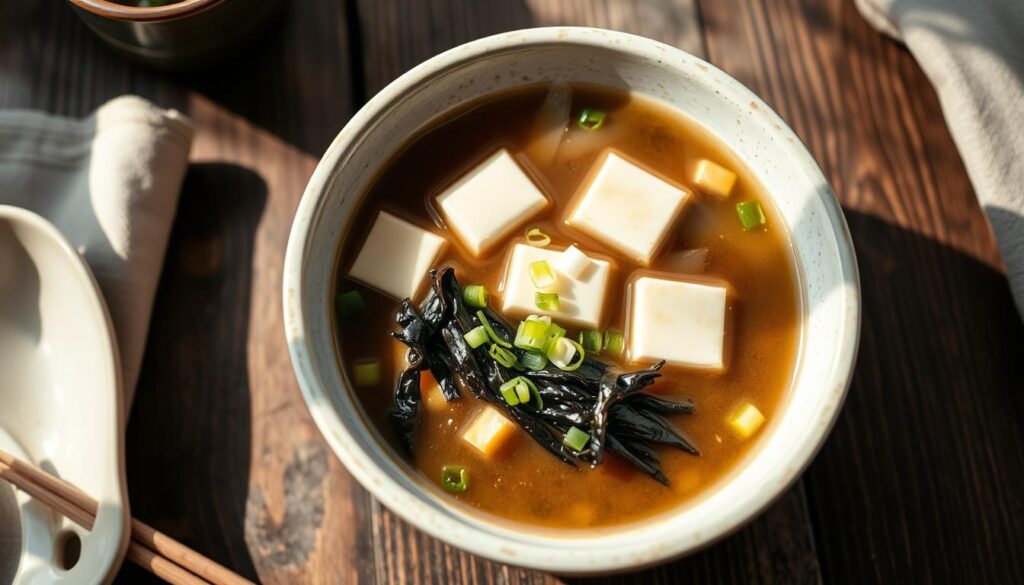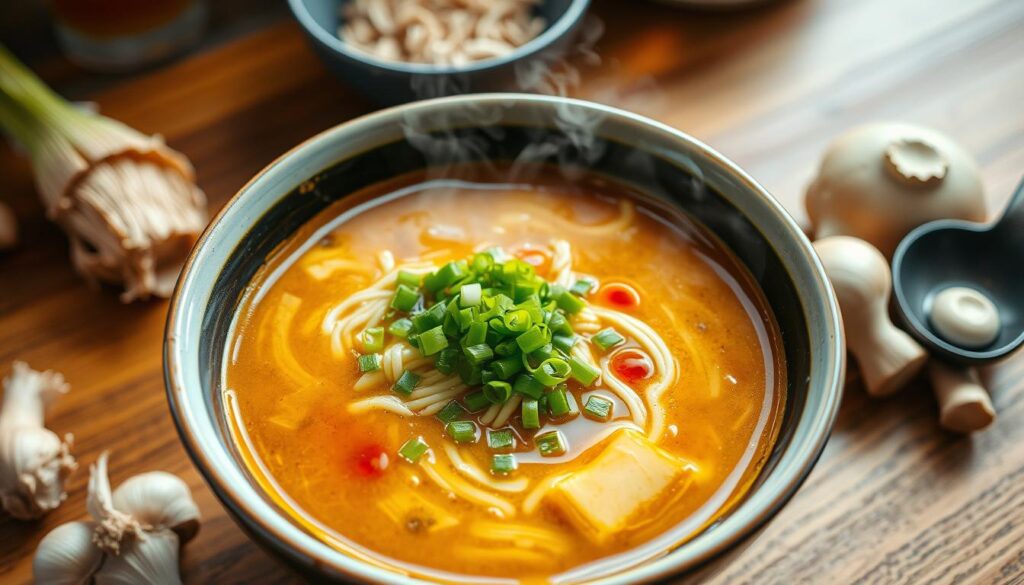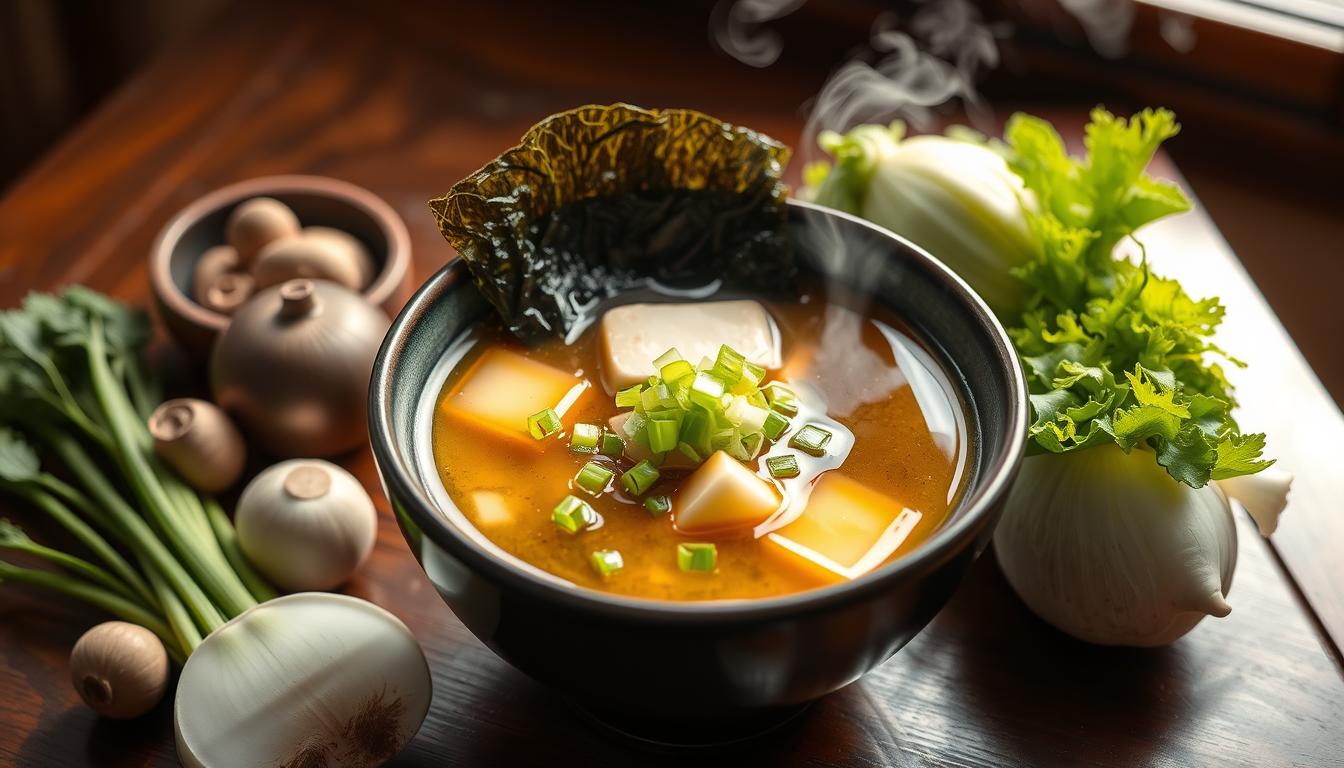Winter brings a cozy feeling, and nothing beats a warm Japanese soup. From the rich taste of miso to the fun slurps of ramen, these dishes are a treat. Whether you love soups or are new to Japanese flavors, these recipes will excite your taste and warm your heart.
Key Takeaways
- Discover a diverse array of Japanese-inspired soup recipes, from classic miso to hearty ramen.
- Explore the cultural significance and health benefits of traditional Japanese soups.
- Learn the art of creating authentic dashi, the foundation of many Japanese soup recipes.
- Understand the importance of ingredient selection and cooking techniques for perfecting your Japanese soup creations.
- Avoid common mistakes and master the art of making delicious, flavorful Japanese soups at home.
Understanding Japanese Soup Culture and Traditions
Japanese soups are deeply rooted in the country’s culinary heritage. They are not just food but a key part of traditional dining. Often, they start a meal, setting the tone for what’s to come.
Cultural Significance in Japanese Cuisine
In ancient Japan, soups were traditionally made with rice, vegetables, and fish. This was because of what was available locally. Buddhism’s influence led to vegetarian soups like kenchinjiru, fitting Buddhist dietary rules.
New ingredients and cooking methods, like tempura from the Portuguese, added variety. This shows how Japanese cuisine has grown and changed over time.
Traditional Serving Customs
- In traditional Japanese meals, soups are served first. They prime the palate for what’s ahead.
- Soups are also key in Japanese ceremonies and festivals. They show their deep cultural importance.
- The order of eating in a traditional Japanese meal is: soup, rice, main dish, sides, and then repeat.
Health Benefits and Wellness Aspects
Japanese soups are not only tasty but also good for you. Hot soups warm you up in cold weather. Light, chilled soups are perfect for summer.
The dashi stock and miso paste in many soups are packed with umami. They’re believed to have health benefits. This makes Japanese soups a nutritious and enjoyable part of the culinary tradition.
“Japanese soups are not merely sustenance but an integral part of the traditional Japanese dining experience.”
Essential Ingredients for Japanese Soups
Japanese soups are famous for their rich flavors and health benefits. At their core are a few key ingredients. These include miso paste, kombu, and wakame, each adding its own special touch.
Miso paste, made from fermented soybeans, is a must-have. It brings a deep, savory taste and health benefits. Kombu, a dried kelp, adds a rich, earthy flavor. Wakame, a seaweed, gives a soft texture and a hint of the sea.
Silken tofu is also a key ingredient, adding a creamy texture and mild taste. Mushrooms, green onions, and carrots are often used too. They add color, crunch, and more flavor.
To make great Japanese soups, knowing these ingredients is key. By using them carefully, you can make bowls that are both nourishing and full of flavor. This brings the true taste of Japanese cooking to your table.
| Ingredient | Role in Japanese Soups |
|---|---|
| Miso Paste | Provides rich, umami-packed flavor and probiotic benefits |
| Kombu | Infuses broths with a deep, earthy essence |
| Wakame | Lends a delicate texture and subtle ocean-like notes |
| Silken Tofu | Adds a soft, creamy texture and mild flavor |
| Vegetables (Mushrooms, Green Onions, Carrots) | Contribute color, crunch, and additional layers of flavor |
“The key to an outstanding Japanese soup is the thoughtful choice and balance of its fundamental ingredients.”
Mastering Dashi: The Foundation of Japanese Soup Recipe
Dashi is a secret ingredient in many Japanese soups. It adds a rich umami flavor that makes each spoonful special. We’ll look at the different types of dashi, how to make it, and how to store and use it.
Types of Dashi Stock
Dashi can be made from various ingredients, each with its own taste. The most common types are:
- Kombu Dashi: Made from kelp, it’s vegetarian-friendly and has a clean, sweet taste.
- Bonito Dashi: Made from dried and smoked tuna flakes, it has a deep, savory umami flavor.
- Shiitake Dashi: A vegetarian option made by simmering dried shiitake mushrooms, it adds an earthy, umami taste.
The Step-by-Step Dashi Making Process
Making dashi stock is a delicate process. Here’s a simple guide:
- Use high-quality ingredients like Ocean’s Balance Whole Leaf Kombu and Bonito Flakes.
- Simmer the kombu in water for 10 minutes, then add the bonito flakes and steep for 5 more minutes.
- Filter the liquid through a fine-mesh strainer, removing the solids.
- Your flavorful dashi stock is now ready to use in Japanese soup recipes.
Storage and Usage Tips
Dashi is versatile and can be stored and used in many ways:
| Storage | Usage |
|---|---|
| Refrigerate for up to 4 days | Use as a base for miso soup, nimono (simmered dishes), and nikujaga (meat and potato stew) |
| Freeze for up to 3 months | Enhance the flavor of rice dishes, sauces, and marinades |
Mastering dashi-making unlocks the authentic flavors of Japanese cuisine. Use this versatile stock to elevate your dishes.
Classic Miso Soup: A Beginner’s Guide
Miso soup is a favorite in Japanese cooking. It mixes the rich umami of fermented miso with the warm dashi broth. It’s a tasty and healthy dish that shows off Japanese food traditions. This guide will help you make the perfect bowl, whether you’re new or looking to improve.
The key to miso soup is the miso paste. Shiro miso, or white miso, is a good choice for beginners. It’s milder and sweeter, perfect for adding toppings like silken tofu and wakame seaweed. Making it takes just 15 minutes, making it a quick and healthy meal.
- Dashi stock: This savory broth is the base of miso soup. It’s made with kombu (kelp) and katsuobushi (dried bonito flakes).
- Miso paste: Shiro miso is a good start because it’s mild and sweet. You can modify the quantity to suit your taste.
- Silken tofu: This soft tofu adds creaminess and protein to the soup.
- Wakame seaweed: These green strips add a salty flavor and lots of nutrients.
- Scallions: A fresh garnish that adds a hint of onion flavor.
To make the perfect miso soup, start by heating the dashi stock. Then, whisk in the miso paste until it’s fully mixed. Add the tofu and wakame, letting the flavors mix for a few minutes before serving. This creates a comforting bowl that shows off Japanese cuisine.
“Miso soup is not just a dish – it’s a cultural experience that nourishes the body and soul.”
Miso soup is great as a light meal, a starter, or a daily tradition. It lets you experience Japanese food traditions. Enjoy the simplicity and richness of this classic dish and explore the world of miso soup.

Hearty Udon Noodle Soup Preparation
Udon noodle soup is a comforting dish with thick, chewy noodles in a savory broth. It’s ideal for anyone who enjoys Japanese cuisine. Let’s explore how to make this delicious soup.
Choosing the Right Udon Noodles
The quality of the noodles is key for a great udon noodle soup. Udon noodles vary in shape, texture, and thickness. You can find them frozen or dried, or even make them from scratch. Explore different varieties to discover your favorite.
Broth Making Techniques
A flavorful broth is essential for a good udon soup. Start with a rich dashi stock, a base for many Japanese soups. Mix it with soy sauce, mirin, sake, sugar, and salt for a deep, umami flavor. Simmer the broth gently to blend the flavors.
Traditional Toppings
- Green onions: Finely sliced for a pop of freshness.
- Shichimi togarashi: A fragrant Japanese spice blend adding heat and complexity.
- Inari age: Seasoned and fried tofu pouches for a savory touch.
- Shrimp tempura: Crispy and indulgent, a classic udon topping.
Try different toppings to make your udon noodle soup your own. Add vibrant veggies or delicate proteins. Serve it hot and enjoy the warmth and texture.
Ramen: From Simple to Spectacular
Explore the world of ramen and learn to make these tasty noodle soups. Whether you’re new to ramen or love it, there’s a recipe for you. You can make quick ramen in 30 minutes or spend hours on a rich broth.
Try the yuzu shio ramen for a citrusy twist. Yuzu adds a unique flavor to the broth. By playing with broths, noodles, toppings, and seasonings, you can make your own special ramen.
Customizing your ramen is fun. You can choose from many broths like tonkotsu or shoyu. Add different noodles and toppings like pork belly or vegetables. Finish it with a perfectly cooked egg.

Learning to make ramen is rewarding. With the right ingredients and techniques, you can improve your cooking. Enjoy the variety of ramen and let your taste guide you.
| Ingredient | Quantity |
|---|---|
| Sesame oil | 1 tablespoon |
| Grated ginger | 3 teaspoons |
| Grated garlic | 4 teaspoons |
| Ramen broth | 4 cups |
| Water | 4 cups |
| Dried shiitake mushrooms | 1 ounce |
| Instant ramen noodles | 2 packages (noodles only) |
| Chopped scallions or chives | 1/2 cup |
| Chopped kale (or spinach) | 2 cups |
| Shredded carrots | 1 cup |
| Sriracha sauce | To taste |
| Panko crumbs | Crunchy golden |
With these ingredients and creativity, you can make amazing ramen. Savor the process and let your taste preferences lead the way.
Seasonal Japanese Clear Onion Soup
Try the light and tasty Japanese clear onion soup, a favorite at hibachi steakhouse spots. It’s made with sweet onions and a savory broth that will make you feel cozy.
Ingredient Selection Tips
For a real Japanese clear onion soup, pick the best ingredients. Use clear onion soup onions like Vidalia or Walla Walla for their mild taste. Add carrots, celery, and mushrooms for a rich yet balanced flavor.
Cooking Methods and Timing
Slow simmering is key for a great Japanese clear onion soup. Start by cooking the onions, carrots, and celery until they’re soft and smell good. Then, add water or dashi stock and simmer for 30 minutes. Strain the broth to get a clear, smooth soup.
| Nutrition Facts | Value |
|---|---|
| Calories | 138 kcal |
| Carbohydrates | 13 g |
| Protein | 6 g |
| Fat | 6 g |
| Sodium | 663 mg |
| Fiber | 3 g |
To finish, top the clear onion soup with scallions and sautéed mushrooms. It looks great and tastes even better. Enjoy the mix of flavors and the cozy warmth of this Japanese dish.
Kitchen Equipment and Tools Needed
Preparing authentic Japanese soups requires the right kitchen tools. An enameled Dutch oven ensures even heating. A fine-mesh strainer helps make clear broths. Traditional Japanese soup spoons are perfect for serving, catching every savory drop.
Having a sharp knife for chopping, measuring cups and spoons for exact amounts, and strong storage for leftovers or broths is crucial. With these tools, you’ll be on your way to making delicious Japanese soups.
Key Equipment and Tools:
- Enameled Dutch oven
- Fine-mesh strainer
- Japanese soup spoons
- Sharp chef’s knife
- Measuring cups and spoons
- Airtight storage containers
| Equipment | Purpose |
|---|---|
| Enameled Dutch oven | Provides even heat distribution for simmering soups |
| Fine-mesh strainer | Helps create clear, flavorful broths by removing impurities |
| Japanese soup spoons | Designed for easy sipping and enjoying every last drop of soup |
“Using the right tools can greatly enhance the process of making authentic and flavorful Japanese soups.”
Common Mistakes to Avoid When Making Japanese Soups
Making Japanese soups at home can be fun and rewarding. But, it’s important to avoid common mistakes. One big mistake is boiling miso paste. This can kill the good bacteria that make miso healthy.
To keep miso healthy, add it at the end of cooking, when the heat is off.
Using low-quality ingredients is another mistake. For Japanese soups, the quality of dashi stock, kombu, and mirin matters a lot. Good ingredients make your soup taste rich and full of umami.
Don’t overcook tofu and seaweed. Tofu should be added near the end to stay soft. Cooking it too long can make it tough or fall apart.
Getting the seasoning right is also key. Japanese soups need a balance of flavors. This includes savory dashi stock, sweet mirin, and salty soy sauce. Finding the right mix of these is important for a true Japanese taste.
By avoiding these mistakes and following traditional Japanese ways, you can make delicious and healthy soups. These soups will take you on a taste journey to Japan.
| Mistake | Explanation | Solution |
|---|---|---|
| Boiling miso paste | Boiling miso paste can destroy beneficial probiotics. | Add miso paste at the end of the cooking process, off the heat. |
| Using low-quality ingredients | Low-quality dashi stock, kombu, and mirin can compromise the soup’s flavor. | Invest in high-quality, traditionally-made Japanese ingredients. |
| Overcooking delicate ingredients | Overcooking tofu and seaweed can make them tough or cause them to disintegrate. | Add tofu and seaweed towards the end of simmering to maintain their texture. |
| Improper seasoning | Japanese soups require a delicate balance of flavors from dashi, mirin, and soy sauce. | Experiment with the right combination of seasonings to achieve an authentic taste profile. |
By avoiding these common mistakes and respecting traditional Japanese techniques, you can create flavorful, nourishing soups that will transport your taste buds to the heart of Japanese cuisine.
Conclusion
Japanese soups are a treasure trove of flavors, from light broths to hearty noodle soups. Learning to make dashi, miso soup, and ramen broth brings authentic Japanese tastes home. Try different ingredients and styles to find your top japanese soup recipe.
Whether you love Japanese food or just want to try something new, Japanese soups are a fun adventure. From the rich miso soup to the tasty ramen broth, each soup has its own taste and story. Dive into the traditions, learn about the ingredients, and let your creativity make unforgettable Japanese soups.
Keep exploring Japanese soups and enjoy every flavor. Appreciate the art and share the joy with your family and friends. Bon appétit!
FAQ
What are some popular Japanese soup recipes to try?
What is the cultural significance of Japanese soups?
What are the key ingredients for making Japanese soups?
How do you make dashi, the base for many Japanese soups?
What is the process for making authentic miso soup?
How do you prepare a delicious udon noodle soup?
What are the different styles of ramen and how do you customize them?
How do you make a classic Japanese clear onion soup?
What equipment is needed for making Japanese soups?
What are some common mistakes to avoid when making Japanese soups?
What did you think of our recipe?
There are no reviews yet. Be the first one to write one.

